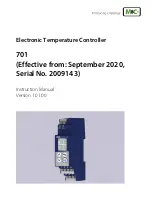
Input Wiring
Note:
Thermocouple circuit resistance
should not exceed 100 ohms for
rated accuracy; errors will occur at
higher resistance values. If shielded
thermocouple wire is used, terminate
the shield only at controller end.
Figure 3. Thermocouple Input Wiring.
Make sure that you are using the
appropriate thermocouple and extension
wire. Connect the negative lead (generally
colored red in ISA-type thermocouples) to
contact #1; connect the positive lead to
contact #2. Extension wires must be the
same polarity as the thermocouple.
6
Series 1ZC Communicating Sub-Panel Temperature Controller
Input, Output,
Communications,
and Power Wiring
IMPORTANT:
All electrical wiring
connections should be made only by
trained personnel, and in strict accordance
with the National Electrical Code and
local regulations.
The 1ZC controller has built-in circuitry to
reduce the effects of electrical noise (RFI)
from various sources. However, power and
signal wires should always be kept
separate. We recommend separating
connecting wires into three bundles:
power; signal; and output. These bundles
should then be routed through individual
conduits. Shielded sensor cables should
always be terminated to earth ground
at the controller end only.
If additional RFI attenuation is required,
install a noise suppression device such as
an R.C. snubber across the external noise
source. If you wish, you may order this
suppressor directly from Athena; specify
part number 235Z005U01.
Figure 2. 1ZC Contact Identification
Legend:
1
Sensor (-)
– Thermocouple, RTD,
or Process
2
Sensor (+)
– Thermocouple, RTD,
or Process
3
Sensor
– Bias for RTD
4
Communications
– RS-485 “A” I/O line,
bidirectional
5
Communications
– RS-485 “B” I/O line,
bidirectional
6
Output 1, Relay
– N.O., solid-state relay:
Load; Process: (+)
7
Output 1, Relay
– Common, solid-state
relay: Load; Process: (-)
8
Output 2, Relay
– N.O., solid-state relay:
Load; Process: (+)
9
Output 2, Relay
– Common, solid-state
relay: Load; Process: (-)
10
Power, Input
– L2 (reference only, no
polarity required)
11
Power, Input
– L1 (reference only, no
polarity required)







































